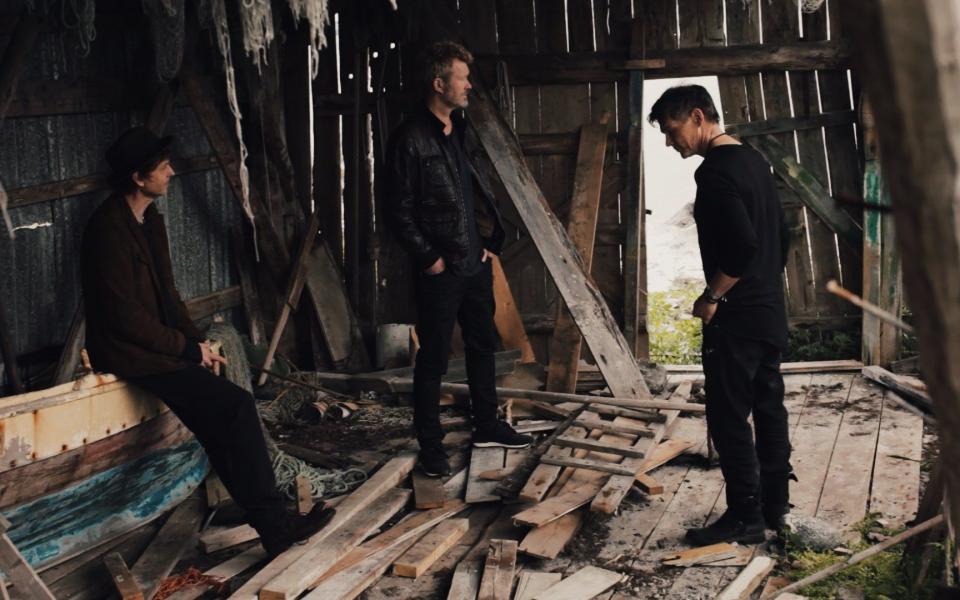Hunting high and low for some jollity in this A-ha documentary

A-ha. A-ha ha ha ha ha. I’m getting the laughs in early, as there is absolutely nothing funny about this documentary about Norwegian synth-pop trio A-ha. It’s ironic that life in the band behind one of the most joyous and enduring hits of the Eighties – the uplifting, catchy Take On Me – appears to be as pleasurable as a wet weekend in Bergen.
How I wished it were different. Those colourful appearances in Smash Hits! Singer Morten Harket’s agglomeration of noodle-thin leather bangles! The greasy bouffant hair that I, like many, tried but failed to replicate! The dopamine rush of Magne Furuholmen’s synth riffs! They all masked various levels of dissatisfaction and rivalry within Norway’s biggest ever band. Strewth. We’re already dealing with the tail end of a pandemic, a cost-of-living crisis, and rampant inflation – did we really need to be told this as well?
There’s a double irony here too. The influence of Take On Me, always popular, seems to have reached new heights recently. Harry Styles’s current number one single, As It Was, is clearly indebted to the song, while The Weeknd’s Blinding Lights – the most streamed song on Spotify in 2020 – shares much of its sonic DNA. A-ha: The Movie might, then, have been a celebration. Alas no.
A-ha formed in Oslo in 1982 and moved to London to seek fame and fortune. They lived on the breadline in a series of increasingly run-down flats. Lack of money sent them further away from the centre of town every time they moved: Notting Hill one month, Willesden Green the next. But helped by Take On Me and its groundbreaking video, which showed the band leaping in and out of the pages of a comic, their 1985 debut album Hunting High and Low sold 11 million copies. They topped the charts in America, did a Bond theme and became megastars.
But the problems, to boil down the essence of this nearly-two hour documentary (it’s at least 20 minutes too long), seem to have been as follows: heartthrob Harket believes he was singled out by the media and has therefore struggled with fame, Furuholmen believes his keyboard contributions to A-ha’s music have been overlooked, and guitarist Pål Waaktaar-Savoy wishes he was in Echo & The Bunnymen. Indeed the brooding, ambitious Waaktaar-Savoy appears to be kernel of much of the dissatisfaction. A dominant songwriting presence in the studio, he always thought Take On Me was too commercial. The song even came to be known by the band as The Juicy Fruit song as it sounded like an advert.

And this pull between chart ubiquity and record company expectations on the one hand and the desire to be seen as “serious” musicians on the other has characterised A-ha’s career. Their albums have swung like pendulums: that poppy debut was followed by sincere second album Scoundrel Days, whose surly lead single Manhattan Skyline lost them their US audience, and was duly followed by a poppy third LP, which was in turn followed up by more earnest, U2-like fare on the fourth. And so on. And on, as it turns out.
Thomas Robsahm and Aslaug Holm’s film contains some fascinating scenes and nuggets. Snippets of Harket clubbing in New Romantic gear in early-Eighties London are wonderful, and we learn of an interesting falling out with composer John Barry over some chords in their Bond song, The Living Daylights. Harket, we’re told, used to gel his hair using house paint when he ran out of money (that’s where I was going wrong!). And recreations of the comic book scenes from the Take On Me video are used as clever framing devices in the movie. What’s equally notable was the singer’s objectification as a sex symbol by the press. At one point, a female journalist asks him to “strip to the waist” for her. His defensive answer is equally un-PC. “Sure. If you do the same,” he says, rather awkwardly.
But the film suffers for a number of reasons. It’s brutal honesty makes it brutally depressing. At one point, Furuholmen says the process of recording together again would make them want to “bash each other’s brains out”. Which is cheery. (Furuholmen is also revealed to have a heart condition at the end, just to add to the fun). And the documentary lays out A-ha’s long career chronologically, meaning that we get a series of narrative peaks and troughs rather than a satisfying arc.
Ultimately, A-ah: The Movie is a curate’s egg. It’s not in the territory of Metallica’s Some Kind of Monster – a documentary that shows a band in full meltdown mode – but nor is it as colourful as the 2018 documentary Bros: After The Screaming Stops. The film, rather like being in A-ha, just comes across as a bit of a slog.
12A cert, 108 min. In cinemas from May 20

 Yahoo News
Yahoo News 
